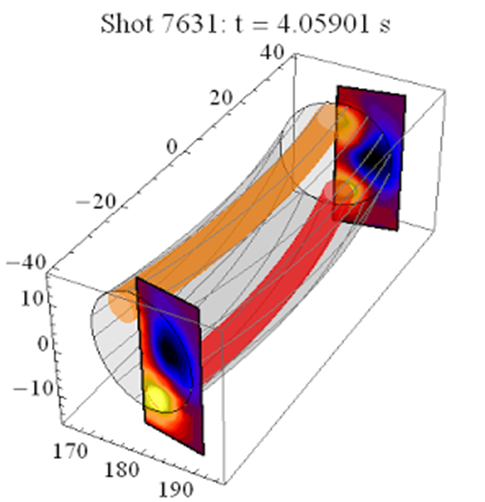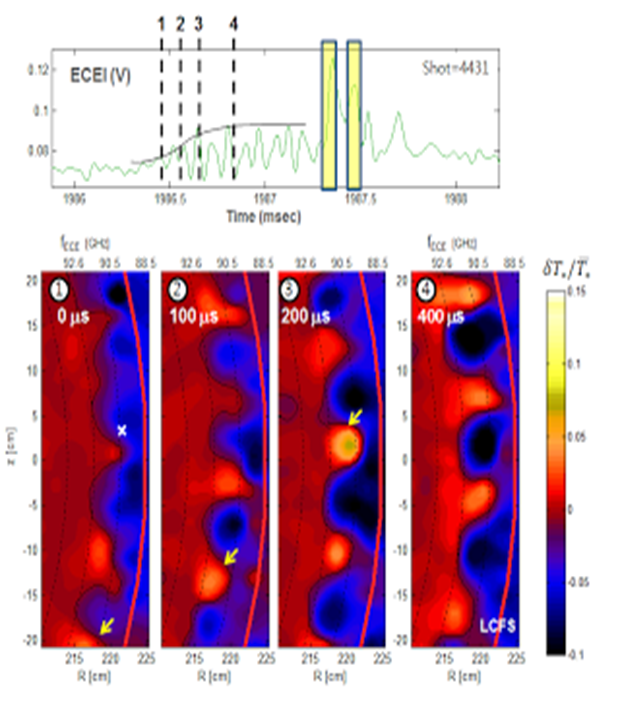MHD instabilities
페이지 정보
2017-02-07 15:39:51 / 3283본문


자기 유체 역학 (Magnetohydrodynamics, MHD)는 플라즈마와 같은 전기 전도성 유체의 자기적 특성에 대해 연구하는 학문이다. 아래는 KSTAR ECEI 장치로 관측한 MHD 불안정성 현상들의 대표적 예다.
(1) 플라즈마 내부 불안정성 현상
아래의 quasi-3D 이미지는 KSTAR 내에 설치된 ECEI 장비를 이용하여 측정한 영상이다 [2].
플라즈마 중심 영역에서 전자 사이클로트론 주파수 가열 혹은 유도 전류로 발생하는 tearing instability를 통해 여러 개의 플럭스 관이 형성된다.
현재의 연구는 multiple tearing mode에 대한 3D 섭동 구조의 영향에 중점을 두고 있으며, 이는 sawtooth와 같은 불안정성을 제어하는데 중요한 역활을 할 것으로 보고있다.
(2) 플라즈마 경계면 불안정성 현상 (Edge Localized Mode: ELM)
High confinement mode (H-mode)는 플라즈마 가둠 상태를 향상시키는 것으로 알려져 있고, 가장자리 부근에 가파른 압력 경사가 형성되어 있는 것이 특징이다. 가파른 압력 경사는 ELM을 야기하고, 압력 경사를 붕괴시킨다.
KSTAR ECEI 시스템을 통해, 이런 ELM 현상이 발달하는 과정을 2D 이미지로 측정하는데 성공하였다.아래의 이미지는 KSTAR에서 관측한 ELM의 성장을 자세히 보여준다. [3]
High temperature plasmas can be confined by strong magnetic fields (both externally applied and self-generated) in devices such as tokamak. Magneto-hydrodynamics (MHD) is the study of equilibrium states and instabilities in magnetically confined plasmas. (*tokamak: a doughnut-shaped device containing hot magnetized plasmas) We investigate the nonlinear dynamics of MHD instabilities using our world-best imaging diagnostic tools at the KSTAR tokamak.
(1) Internal instabilities driven by currents
Dual flux tubes formed via a current-driven tearing instability in the plasma core region (KSTAR shot# 7631) [2].
This quasi-3D image is taken by two microwave cameras which measure the electron cyclotron emissions from the plasma. (*Work published in Phys. Rev. Lett. 109, 2012).
Current research focuses on the simulation of multiple tearing modes (in collaboration with Dr. A. Bierwage) and the effect of the 3D perturbation structure on the mode stability.
(2) Instabilities in the plasma edge
The edge of the tokamak plasmas with reduced transport (so called high-confinement regime) has a steep pressure gradient, a source of free energy for instabilities [3].
Filamentary instabilities naturally develop, undergo complex dynamical changes, and eventually burst causing a rapid loss of heat and particles.
Such instabilities are termed as Edge Localized Modes (ELMs).
The sequence of images below illustrates the ELM growth in detail observed at the KSTAR (* Work published in Phys. Rev. Lett. 107, 2011).


